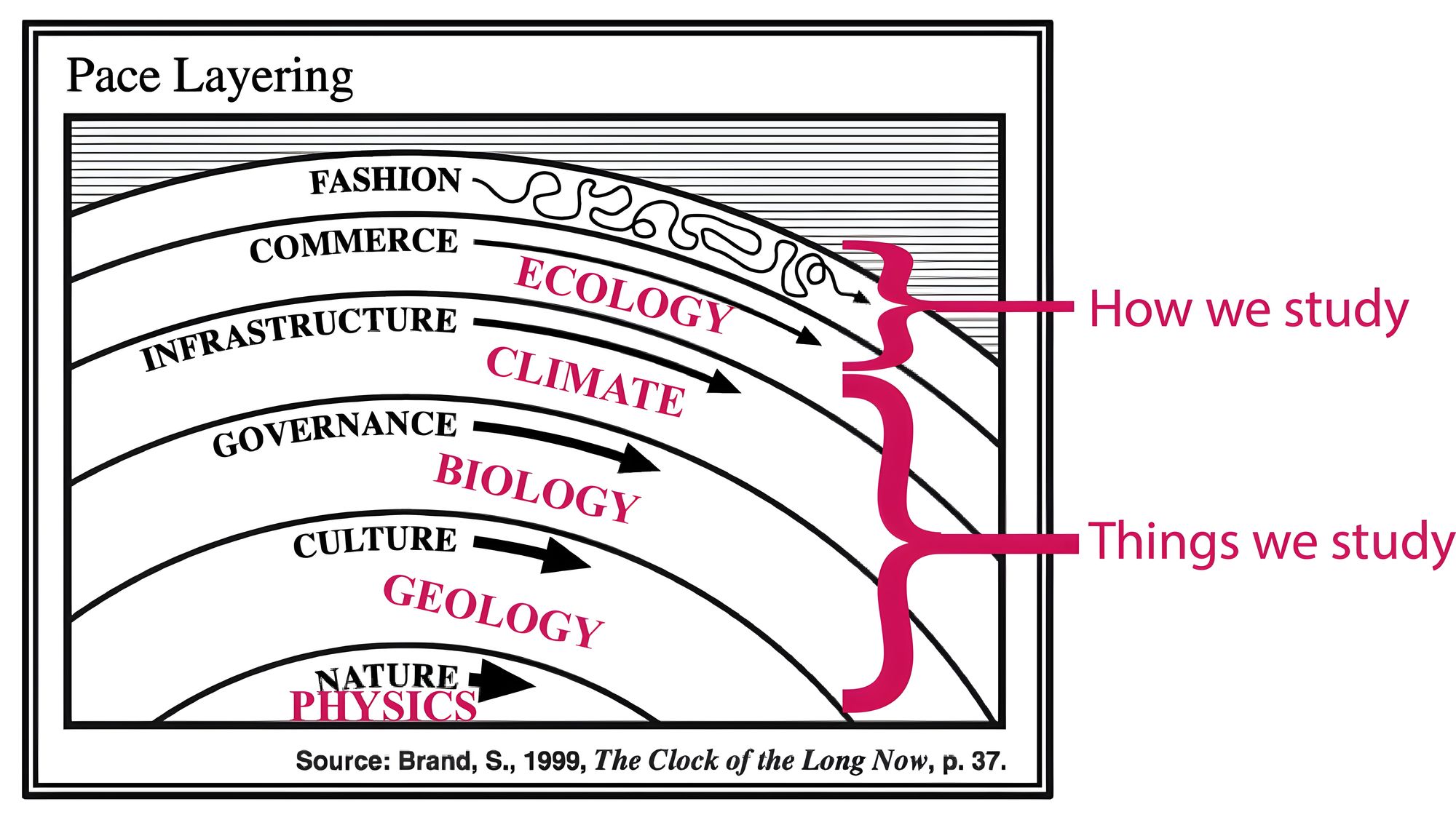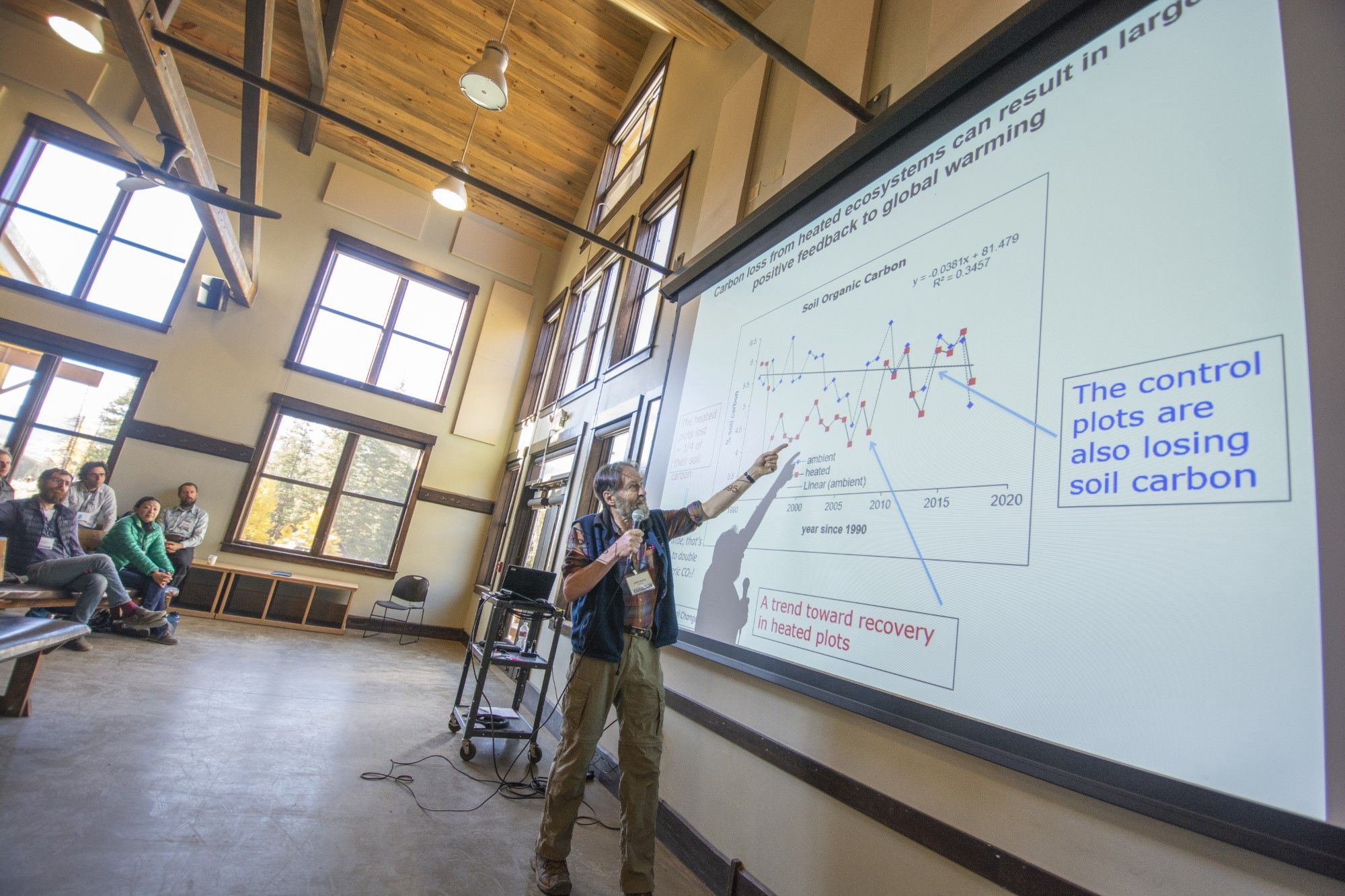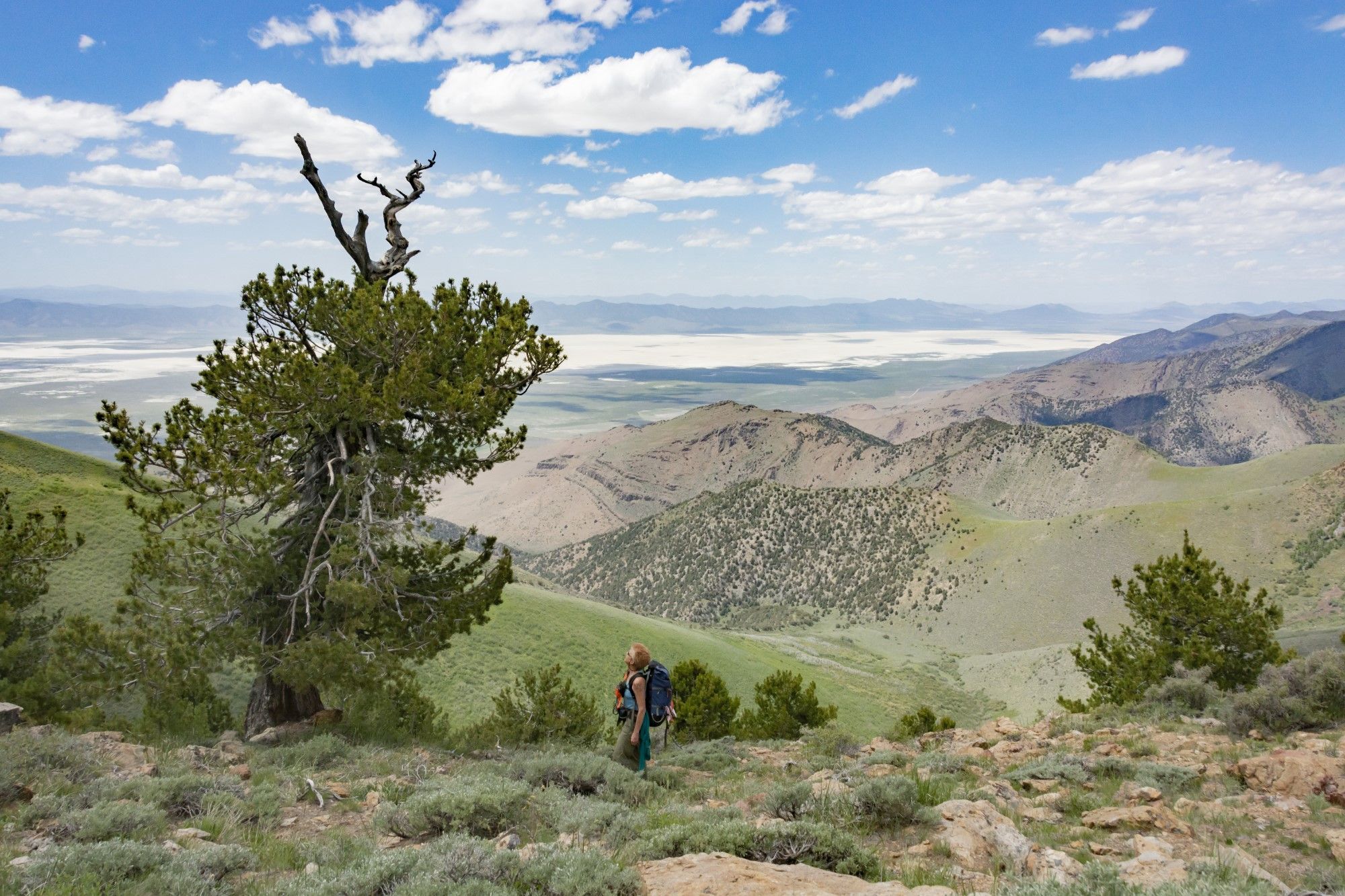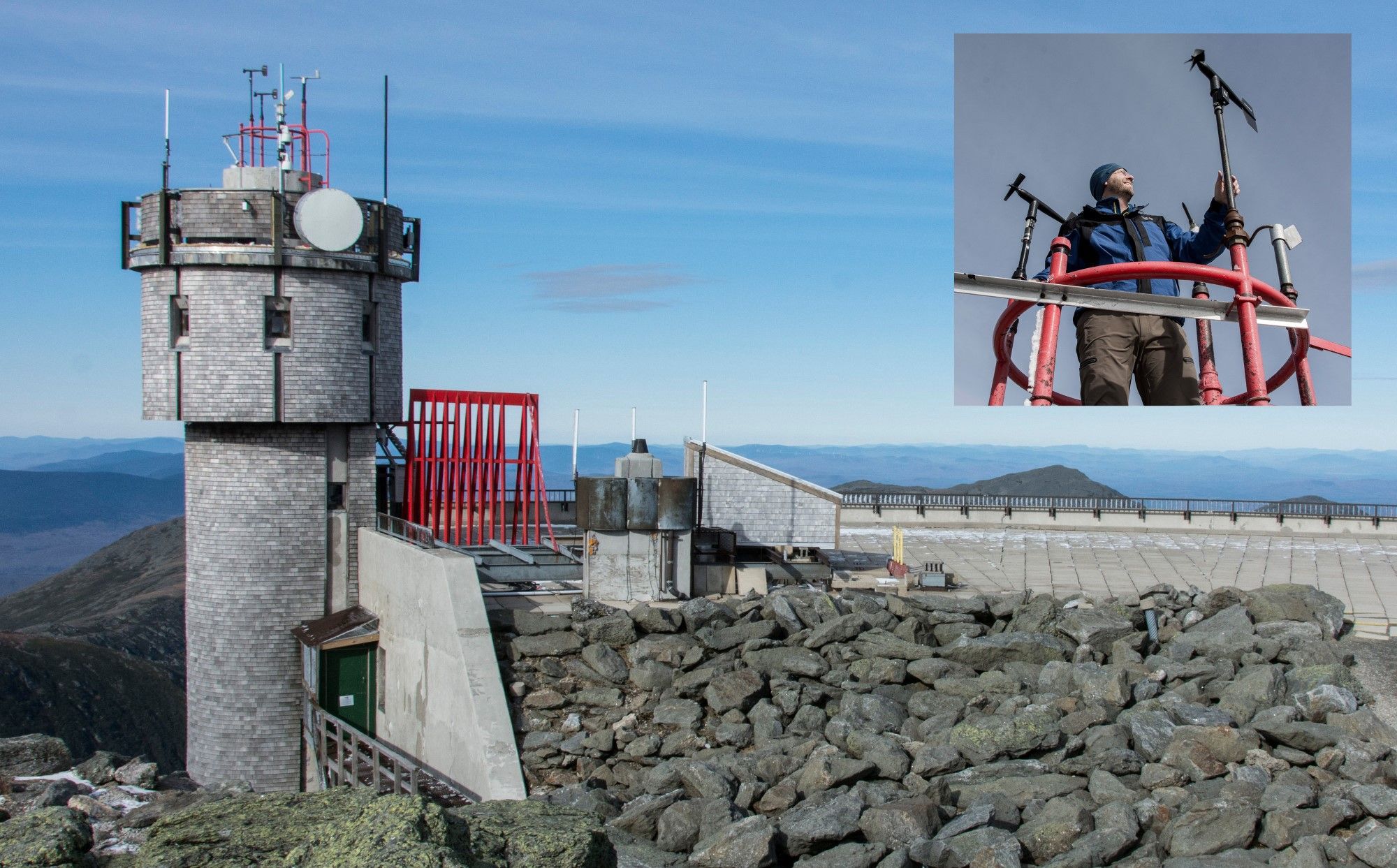Wind cutting across my cheek, I marched across a grey, sharp limestone slope at treeline in the Great Basin. The tinkle of rock under shoe and a light whistle of air though bristlecone pine krummholtz were the only sounds heard in a stark, seemingly timeless landscape. Oh, and labored breathing at 3500 m elevation. I was here at the summit of Mt. Washington, Great Basin, North America, to eavesdrop on an art project idea that would predict the slow advance of bristlecone growth over thousands of years (Fig. 1).
I caught up with the artist team downslope in a grove of both live and long since expired trees, listening to brainstorming about how to demark growth extents of stems over millennia. It hit me as I reviewed the various strategies that even the artists seeking to communicate vast differences between human and tree timescales were struggling with the realities of nature’s physics.
“Hey gang, let’s put on our ten-thousand-year goggles. You need to view the eroding soil column more like a fluid on this slope.”
“Wait, what?”
Science, as it turns out, is not very different in this regard — with the human element as the common denominator. Short-term demands of the mission, personal experience, economic drivers, and community dynamics often shape scientific work far more than we are willing to admit. As science continues to evolve from infancy into adolescence, it adopts the aggregate behavioral norms of the human participants (Fig. 2).

Looking at Western culture as an incubator of modern science, we can readily draw parallels in research with the societal cycles of fashion, entertainment, politics, finance, and international conflict. Alarmingly, as science becomes “mainstream”, these short-term cycles increasingly impact how science is “done”. And, more importantly, how science is taught. These issues pervade all fields of inquiry, and mountain science is no exception. At the recent MtnClim 2018 conference, held at Rocky Mountain Biological Laboratory in Colorado, I was refreshed to see venerated attendees describing common measurements of physical processes spanning decades of time. True “Long Science” being done in relatively simple ways like dedicated billy barr’s weather observations, or in more elaborate schemes requiring electricity and endless counting mantras like Dr. John Harte’s 28- year meadow warming experiment (Fig. 3).

This “observatory” or “Long Science” approach of establishing long-term, regular, repeated measurements that may be evaluated over time for bias, error, and repeatability is a mindset that goes far back into the evolution of scientific research itself. Particularly in the environmental sciences, where strict laboratory control of variables and time is simply not possible. Sadly, one need only look at the stream of modern publication titles and abstracts to see that this approach is far from common in today’s Research Economy.
Science-meets-unfettered-Capitalism is the order of the day in the race for bibliometrics, and “by any means necessary” is dangerously close to being normalized. For environmental science, drivers are typically management or policy objectives as opposed to pure inquiry (true discovery science doesn’t pay anymore). Landscape management or resource policies are generally focused on conditions (snapshot) as opposed to a layered, complex process (ain’t nobody got time for that). The trends play out as we watch budgets for in-situ environmental observations shrink across agencies and governments. Arguably, the technology for comprehensive airborne/space (remote) sensing is still quite crude and we are far from scaling high-resolution tools across space and time to replace lost ground stations.
At the plot scale, we actually know very little. When listing the chain of critical processes to, say, account for the life of a bristlecone pine (microbiome, cellular physiology, phenological plasticity, soil hydrology and evolution, precipitation rate and phase, competitive interaction, radiation budget, vapor pressure deficit, and dozens of other key variables), we quickly run out of our knowledge comfort zone even at single timesteps! Environmental science is truly still in infancy, and we place our collective reliance increasingly on “modeling” using drive-by data collected with the research equivalent of stone tools (Fig. 4). Rather, establishment of “Long Science” observatories in mountains offers a natural antidote to our default snapshot, tunnel-vision approach in environmental research.

First of all, mountains represent those critical landscapes of process and change that in turn affect all things below them. Societal concern about water supply, hydroelectric power, weather, timber resources, recreation, wildfire, and so forth is inextricably linked with mountain environments. Thinking about, designing for, and communicating the links between mountains and populated lowlands force expanded views on all sides of the conversation. Science in mountains demands greater integration of cross-domain knowledge and expertise. It certainly brings with it a physical reality of long-term dynamism as well as rapid change across space. Single-species conservation focus, for example, becomes difficult to apply in this holistic spatiotemporal perspective.

Secondly, it happens that direct monitoring of the environment decreases dramatically as elevation increases. Comprehensive observational science in mountains is comparatively rare (Fig. 5). Those of us who work in these fields understand why: it is difficult, expensive, and complex — relative to performing the same work in more benign geography. Study design, activity planning, support logistics, equipment maintenance, replication, and data continuity all take on new dimensions when we bring science to mountains. It forces us to think longer and harder about exactly what we are trying to accomplish, and how much we are willing to pay for or endure to meet rigorous standards of study (Fig. 6). It also means we are still on a steep learning curve.

Finally, it is that merging of applicability and cross-domain synthesis, combined with the functional challenges, which can rebuild the original wide-eyed mentality of observation and discovery. The mountain observatory approach is the scientific equivalent of making a difficult pilgrimage to sacred location, perhaps confronting demons along the way, to experience something that cannot be fully anticipated and requires much meditation to digest. A scientist dedicated to making observations in mountains over a continuous period must by necessity participate in the extremes of season; must plan for the decade-to-decade changes of soil, rock, vegetation, snow, ice, and weather; must face the realities of a dynamic environment that has few pre-existing records, and prepare to be surprised.
Humans, mountain art teams, and scientists of all disciplines avoid surprises out of habit, unless perhaps inside a dim movie theater or at a friendly birthday party. Surprise in the sciences can mean significant datasets reduced to uselessness, or, heaven forbid, years of assumption uncovered. This dichotomy of “surprise is necessary” for scientific progress certainly clashes with the human preference for security, but demands introspection.
Thus, the surprises, difficulties, and uncertainties of maintaining “Long Science” in mountains do not lend themselves well to the socio-economic demands of acceptance and tenure, of community consensus and funding, or even of frequent “groundbreaking” publication. Yet, the need/availability ratio of mountain observations remains higher than ever. It is research on the frontier of environmental knowledge, extending away from the trampled corridors of niche focus, aggregating assumption, and coveted publicity. A more poignant self-reflection by the community might be to determine how representative these trends are of evolution in scientific progress. But the mere fact that large and empty regions still exist on the map of earth systems, with rumors that “there be dragons”, should stir the intentions of the historical von Humboldt or the fictional Maturin in all of us hoist the sails of the good ship Surprise for a Long Science adventure.
All photos by the author. Originally published in Mountain Views Vol. 12, №2 Fall 2018, Consortium for Integrated Climate Research in Western Mountains. Reprinted with permission.